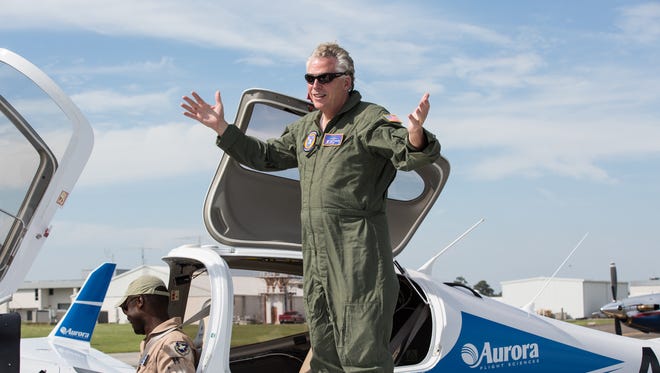1st in flight: Va. governor opens Wallops drone facility
 Jeremy Cox
Jeremy Cox
Terry McAuliffe was all smiles as he clambered out of the cockpit of an airplane after an 11-minute flight like no other in his life.
Clad in a green flight jumpsuit, the Virginia governor pronounced the experience “great.” Now, he said, he could officially lay claim to being the first sitting head of a state to fly aboard a drone.
“I am never flying ever again in a plane with a pilot,” McAuliffe joked as he stood on the tarmac at NASA’s Wallops Flight Facility on Thursday afternoon.
The pilot, in this case, was McAuliffe himself — sort of. He pressed buttons on a laptop, relaying commands to a robot, which actually carried out the functions of a pilot inside the Diamond DA-42 plane.

Per Federal Aviation Administration dictate, an actual, fully licensed pilot was seated next to him the whole time. Her services proved unnecessary.
The governor’s presence in this far corner of the Eastern Shore marked the opening of a new $5.8 million runway built specifically for drones.
NASA and the Virginia Commercial Space Flight Authority collaborated on the project, which they hope will bring more business to Wallops.
“This business is very competitive, not only from a government point of view but also from a commercial point of view,” said Dale Nash, the flight authority’s executive director.
He touted the runway’s unique status as a federal facility, which provides users with 75 square miles of restricted airspace to safely test new technologies. The remote location also ensures that work can be done without fear of trade secrets getting exposed, Nash said.
RELATED: Unmanned boats in Wallops' future?
For all of its high-tech aspirations, the gleaming-new runway is marked by a rustic feel.
The facility — if a long strip of asphalt can be called a “facility” — was hacked from the surrounding wilderness at the northern tip of Wallops Island just months ago. Bug spray is a must for the deer flies, particularly in late May, as several members of the media learned.
The runway darts for 3,000 feet arrow-straight and 75 feet in width between the bay and the Atlantic Ocean. That east-west orientation, officials say, ensures that drones are less vulnerable to dangerous side gusts from prevailing winds during takeoffs and landings.
As if in defiance of those well-laid plans, the wind Thursday blew steadily from the south. But it didn’t seem to impede the drone that buzzed the runway twice for the onlookers below.

Wind concerns were at least partially to blame for the demise of the runway previously used for drone flights on the island.
That runway, constructed in 2003 and extended in 2005, runs north and south, so its availability is limited to use under certain weather conditions. What’s more, at 1,500 feet in length, it is only large enough for the most modest of drones.
Virginia’s hopes for its role in the drone marketplace are anything but modest.
The Association for Unmanned Vehicle Systems International has estimated the total economic ripples of drones during the first three years they were integrated into the national airspace in the United States at more than $13.6 billion, with more than 70,000 jobs created.
The impact on Virginia could be $342 million by 2025, it said.
The commonwealth received a crucial boost in 2013 when the Federal Aviation Administration designated it as one of six test sites for development of unmanned aerial systems. The Virginia Tech-led partnership includes locations in Virginia, Maryland and New Jersey.

With the new, longer airstrip, the facility may host up to 1,040 drone flights a year, an average of about four per day, according to NASA projections.
McAuliffe, during a news conference before his aerial jaunt, compared the runway’s completion to another vaunted event in aviation history: the first flight of the Wright brothers’ plane.
“This is a piece of history we are celebrating today,” he said. “No other state in the United States will have it. I always say I want Virginia to have the first and the best.”
Mark Cherry is president and chief operating officer for Aurora Flight Sciences, a company in Manassas developing drone technology. It is the maker of the robot-controlled system, called Centaur, that enabled McAuliffe to fly his own plane.
Cherry said he looks forward to using an airstrip in his own backyard. Previously, the company would book flights in California, New York or Maryland to test drones. And the Maryland facility, Patuxent River Naval Air Station, can be used for military-contracted jobs but not commercial projects.
“This test site allows technology to move forward,” he said.
The runway has been used once so far, as a training ground for a group of first responders, Nash said. But its first big test will take place in July when the Navy conducts drone testing using Northrup Grumman-made vehicles.
The idea for the governor to ride aboard a drone came together at a recent industry conference in Dallas, where he was promoting the state’s latest piece of infrastructure.
Once back on the ground, he said, the whole process was very simple. He simply pressed buttons to tell the robot what to do, and it did it. The landing was if on a pillow, he added.
A few moments later, he was back in the air, this time aboard a Virginia State Police helicopter.
At the controls sat a pilot.